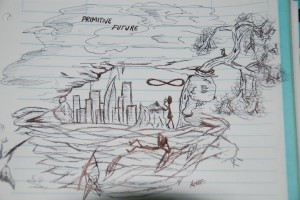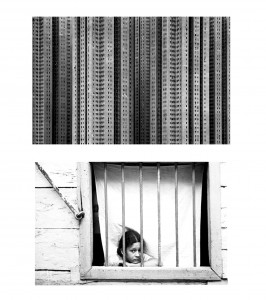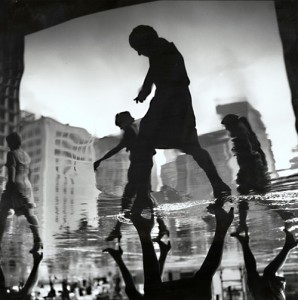In this reading,Rudofsky analyzes through history how humans been have altered in the relationship between nature and architecture itself, stepping outside the narrowly defined discipline that has governed our sense of architectural history and discusses the art of building as a universal phenomenon.
Category Archives: Relational Logic – Critical Readings
OUTDOOR ROOM
Sou Fujimoto´s text analysis – Primitive Future

Relationship between Sou Fujimoto´s Primitive Future and all other readings
In these writing Sou Fujimoto expresses in 20 different main themes his idea of a Primitive Future in architecture. From it we can understand the global relationship between creating spaces from new or existing ones in order to achieve a suitable place for the user.
Fujimoto compares the difference between a nest and a cave, the nest is a tailor made space which suits perfectly to all the necessities of the user, and the cave is an unknown space which has de quality of transformation and creation of infinite connections and uses, depending on who interacts with the space. Read More
“Can we really retreat into self-contained boxes without losing something of the essence of being human?”
“Can we really retreat into self-contained boxes without losing something of the essence of being human?”
Starting from the analysis of the whole and ending up to the particular that is how Rudofsky analyzes the conditions under which the man, specifically the Anglo-Saxon culture, relates intself to the environment in the broadest sense (“The Conditioned Outdoor Room” extracted from the script “Behind the Picture Window”).
Here the Austrian architect consider the history, causes and consequences of the estrangement of the modern-man and his way of living from what he calls the “outdoor room”, that is the missing link between private life and man’s relationship with nature, implicitly criticizing the ideas of order and rationalism of modern architecture.
Interesting is the comparison, in uses and designs, between the ancient Roman peristylium or Japanese gardens and the idea of Anglo-Saxon garden, defined as “un-occupied space”.
In the first examples, nature has a more poetic and a first contact with the “room-mates”, it still being managed by man (“That reverted to indoor outdoor”). It does not happen for the second one, where the garden is a resulting space between houses or a buffer between public space and private area.
At the end, a reflection on that archetype element, such as the wall, considered primarily as a symbol of the tree. The two elements despite being of a different nature, live in a symbiosis of metaphors: sculpture, shadows and reflections, screening, barrier …
The wall as an object full of potential: confidentiality, boundary, separation, window, density / climate utility, density / light …
“The ego as knowledge cannot be understood unless it starts from the exploration of others as knowledge. In this sense, the other is one of the faces of the ego, its possibility still unexpressed, a form of its entity.” Adonis
In the ensuing discussion in the auditorium, through the analysis of the various texts, we have been spoken of the role, and most importantly, of relationships that humans have with its surroundings, architectural and even more. We speculated on the meaning of ENVIRONMENT, on how to change the spaces and how and what we are affected depending on these changes. We talked about the “CHAOS” and the ideological confusion that modern-thinking led to generations of architects, the loss of cultural roots and about a “human (soul) scale” vision of a better world.
Assignment: Critical Readings Summary – Relational Logics
Every student will have to deliver individually a summary in writing to the professor (via IaaC-Blog posted under Critical Readings-Relational Logics category), from the text that he/she has had to read, in a maximum of one page, the relationship with his/her text and the topics exposed in the final debate. Add an image to explain it.
In addition, he/she will have to include a possible topic for personal research, that should have suggested the reading of the text, explained in approximately ten lines.
Deadline: After the puzzle activity, on Saturday, 9th of November 2013, before 10 p.m.
Will always bee human been.
Will always bee human been, is jus a fact, no matter how much we developed we will have to find the way of not been trapped in these new idea of contemporary explorations and isolation of humans without nature, it has to be either the other way around, or will be just in a war trying to play against nature, after reading the Conditioned outdoor room by Rudofsky, there’s something that most of humanity including in a very important space architects we had avoid or maybe just ignored the fact that technology has giving us the tools to create whatever we want , we can be able to alternate in all the ways that we want the climate in a indoor place , but that’s something we may question ourselves. If we have all the tools to improved the living in spaces, why can we just make a interconnection with what the nature has given to us in other to improve with the technology the things we have missed, in other to give humanity the interrelation it’s needed with nature, and not try to abolished this connection with simulations if we already have it? These kind of questioning are the one we should work on in order to produce spaces imaginable, to create a source of invitation to be always in relationship with any kind of activity we have with the environment that its surrounding, and just make it to be always related to our activities: eat, sleep, sex, conversations, work, play, read, cook, etc. We don’t need a division of what’s nature as an outdoor idea to just hang some hours, and later on go inside to have some kind of privacy, nature itself should be privacy and liberty at the same time.
Another point of discussion Is how Rudofsky presents his concerned about the Pilgrims, how they immigrate to another unknown place, with different climates, and conditionings of living, in order to “adapt” itself to a unknown environment and just alternated in a space “capable” for them to live, and we have been seeing this for decades, just breaking the bond of environment with space.
Rufosky also mention another example , is how Pompeii was from the first beginning design to use it climates in other to create space fro acceptable accommodations , but the thing is we still see how we can use our environment in some parts of the day but we are still divided bye these idea that is just for a while and then we just refugee in our “home” just declining the existence and trying label our activities without integrating the nature itself to all of these.
So, may doubt is , are going to be able to just use nature all the time as apart of our all activities and not been just quantifying and qualifying our time spent with our environment itself ? as human been these should be something that comes just along our concerned and humanity itself had created in a unknown way separation that from the beginning should never been there


